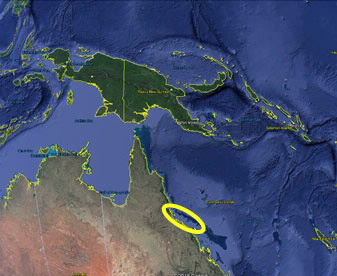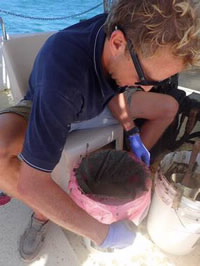ANSTO, in association with James Cook University in QLD, has collected marine sediments from the Australia Pacific Region which will be used to produce Certified Reference Materials (CRMs) by the International Atomic Energy Agency (IAEA) Environmental Laboratories Monaco.
“These sediments join a carefully selected set of global archive samples which provide a record of the earth’s current conditions and ensure quality control when measuring contaminants and trace elements in sediment, seawater and marine organisms,” said Mat Johansen, a senior researcher who specialises in environmental contaminants.
Johansen and Michael Corry (below right) from ANSTO and James Daniell from James Cook University collected the CRM samples under an IAEA project, in coordination with Australian federal agencies.
Marine sediments are important in that they provide a base to marine food webs. They also provide a record of natural and human processes.
“The IAEA wanted samples with trace contaminants, but that were not heavily polluted. They also wanted relatively high organic matter content that is typical of many coastal areas of Australasia” said Johansen.
 |
| Marine samples were collected within the Great Barrier Reef Park with permission. |
After reviewing more than 300 potential locations in consultation with the IAEA, the sediments were retrieved from six widely-spaced sites designed to capture a range of chemical signatures from different coastal features and nearby watersheds. All sites were close to the main Australian landmass, well within the Great Barrier Reef, where finer sediments are deposited.
“Working conditions were not ideal, with steady winds, rough seas, and long days of transit between sites. However, our hosts from James Cook University and boat crew were very reliable, professional and transported us safely to all work sites and helped us a great deal in gathering samples” said Johansen.
 |
The Great Barrier Reef Parks Authority gave permission for the collection of the sediments, which avoided coral, sea grasses and sensitive habitats.
“We collected a total of 320 kg of wet sediment, which is now being kept in storage under cool, dark conditions at James Cook University until subsamples can be tested for levels of contaminants and trace elements,” said Johansen.
A suite of highly sensitive analytical methods will be used to determine the levels of trace metals, radionuclides, chlorinated hydrocarbons and polycyclic aromatic hydrocarbons. Results will add to the international record and will be shared with the Great Barrier Reef Parks Authority and James Cook University for use in documenting long term sediment composition and contaminant trends.
The IAEA takes an ecosystem approach to the management of human activities that may affect the regional marine and coastal environment, in particular seeking to assist Member States to ensure that contaminants do not cause significant impact on coastal and marine ecosystems and human health.
IAEA CRMs are vital for training programs, inter-comparison studies and to assist regional laboratories in maintaining their own quality control procedures.
Published: 15/06/2017


